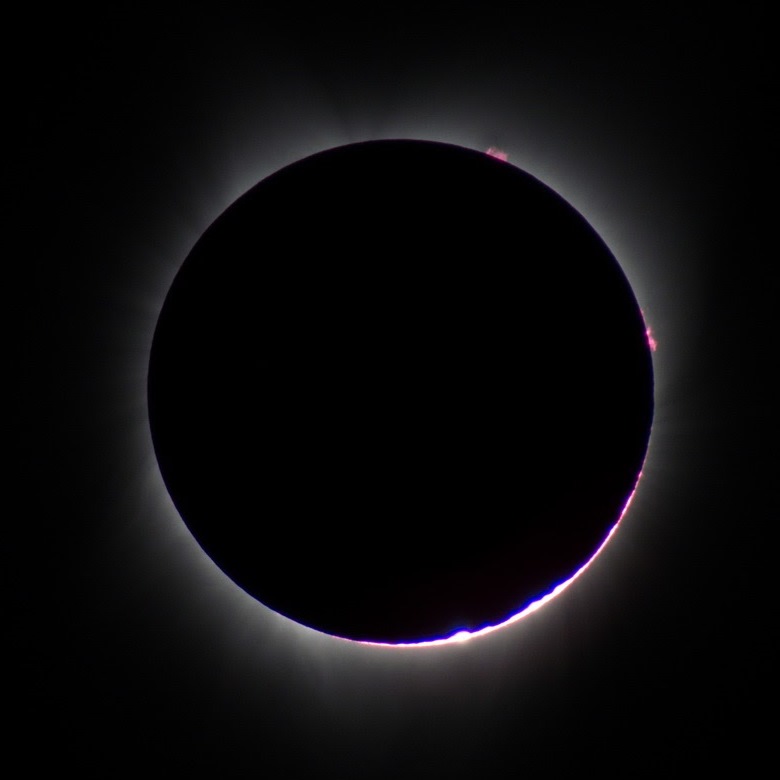On 8 April 2024, people in North America can witness a once-in-a-life-time event. Total solar eclipses are the most spectacular predictable astronomical events. This wonder from the heavens greatly surpasses lunar eclipses, partial solar eclipses or even annular eclipses. I would only rank majestic comets, ultra-strong northern lights and extraordinary meteor showers (which have not occurred in my life time), which are all unpredictable, over total solar eclipses.
 |
| Total solar eclipse of 2017 © Gabriel Chow |
Many amateur astronomers, including myself, would spend years of planning and may have to spend a fortune of money to get to a place in the hope of witnessing the event with favourable weather and cloud conditions. For instance, I flew to Idaho in 2017 and witnessed and photographed the memorable celestial event.
Catholic significance
For Roman Catholics, the Church will celebrate the Solemnity of the Annunciation of the Lord on 8 April in the year 2024. While the feast commemorating the incarnation of Christ is usually celebrated on 25 March, but since the day occurs in the Holy Week this year, it is transferred to the next unimpeded day: Monday after Divine Mercy Sunday.
Solar eclipses used to be associated with disasters; having the incarnation of the Son (Sun) hidden (eclipsed) on that day may signify impending tribulations in the world. The occurrence of this eclipse with rare conditions on the Solemnity of the Annunciation may give an even greater symbolic meaning: will a world war break out any time soon? God may use signs to give us messages, but the faithful have nothing to fear if they trust in the Lord.
Where to see the total eclipse?
Virtually the whole North America can witness a partial eclipse on that day. However, only a small area, called the path of totality, can witness a total eclipse. The path is narrow (usually about 100km wide) and often falls on ocean or uninhabited lands. This total solar eclipse, however, is unmatched in recent history as the path of totality sweeps through many heavily populated areas in multiple states in North America: from Sinaloa, Durango and Coahuila in Mexico, to Texas, Arkansas, Missouri, Illinois, Kentucky, Indiana, Ohio, Michigan (barely touching), Pennsylvania, New York, Vermont, New Hampshire and Maine in USA, and finally to Canada in the provinces of Ontario, Quebec, New Brunswick, Prince Edward Island, Nova Scotia (barely touching) and Newfoundland.
Major cities in Mexico that lie in the path of totality include Mazatlán, Durango, Torreón, Gómez Palacio and Piedras Negras. For USA, the entire major cities of Austin, San Antonio (half of it), Fort Worth, Dallas, Tyler, Little Rock, Evansville, Indianapolis, Dayton, Toledo, Cleveland, Erie, Buffalo, Rochester, Syracuse and Burlington will experience total darkness. In Canada, Hamilton, St. Catharines, Niagara Falls, Kingston, most of Montreal, Sherbrooke and Miramichi also fortunately lie on the path.
Churches that will see the total eclipse
For Catholics, you can watch the total eclipse from many churches that lie on a path of totality. Whereas I counted 744 churches for the total eclipse in 2017, this time the GCatholic database of churches lists 3,217 Catholic churches in North America that will fall on the path of totality. This great number gives a rough estimation of how many more people can see the total eclipse as compared to 2017 as the population roughly corresponds to the church density.
 |
| Around Lake Ontario |
 |
| Fort Worth, Dallas |
 |
| Montreal, Burlington, Sherbrooke |
- Mexico: Durango*, El Salto, Gómez Palacio, Mazatlán*, Piedras Negras, Torreón
- Texas: Austin, Dallas, Fort Worth, Tyler
- Arkansas: Little Rock
- Missouri: Cape Girardeau
- Indiana: Evansville, Indianapolis
- Ohio: Cleveland, Parma (Ukrainian), Parma (Ruthenian), Toledo
- Pennsylvania: Erie
- New York: Buffalo, Ogdensburg, Rochester, Syracuse
- Vermont: Burlington
- Ontario: Cornwall (co-cathedral), Hamilton*, Kingston, St. Catharines
- Quebec: Montreal*, Montreal (Melkite), Longueuil (co-cathedral), Saint-Hyacinthe, Saint-Jean-sur-Richelieu, Salaberry-de-Valleyfield*, Sherbrooke*
- Newfoundland and Labrador: Grand Falls-Windsor
- Indiana: Vincennes
- Ohio: Carey, North Jackson
- New York: Lackawanna, Lewiston, Syracuse
- Quebec: Drummondville, Montreal's St. Joseph, Notre-Dame, St. Patrick
- New Brunswick: Miramichi
- St. Meinrad Archabbey (Swiss-American Benedictine)
- Abbey of St. Benedict, Subiaco (Swiss-American Benedictine)
- Abbey of St. Andrew, Cleveland (American-Cassinese Benedictine)
- Abbaye Saint-Benoît-du-Lac (Solesmes Benedictine)
- Thien Tam Monastery (Subiaco Cassinese Benedictine)
- Our Lady of the Genesee Abbey (Trappist)
- Monastery of Our Lady of Calvary, New Brunswick (Trappist)
- Monastère de Saint-Antoine-le-Grand, Montreal (Maronite)
- Abbey of the Immaculate Heart of Mary, Vermont (Benedictine Nuns)
- Mount St. Benedict Monastery, Erie (Benedictine Nuns)
- Abbaye Notre-Dame-du-Bon-Conseil, Saint-Benoît-Labre (Trappist Nuns)
- Abbaye Notre-Dame-de-l'Assomption, Moncton (Trappist Nuns)
- Abbey of Our Lady of Dallas (Cistercian Nuns)
- Monastery of the Infant of Prague and St. Joseph, Dallas (Discalced Carmelite Sisters)
- Monastery of Our Lady and St. Joseph, New York (Discalced Carmelite Sisters)

